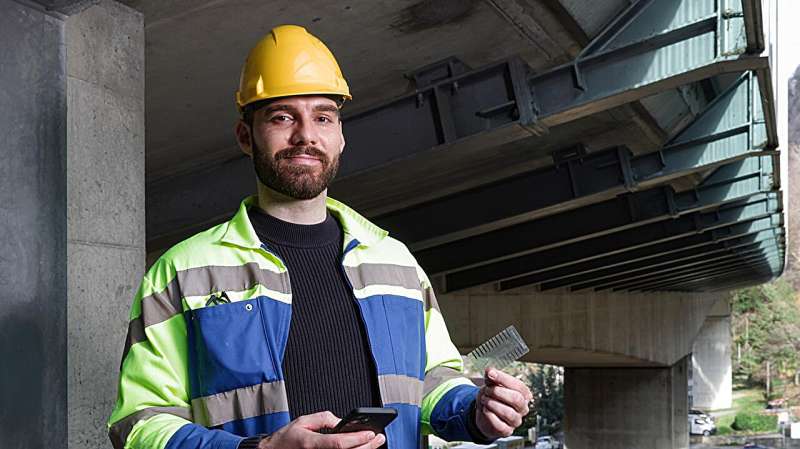This article has been reviewed according to Science X's editorial process and policies. Editors have highlighted the following attributes while ensuring the content's credibility:
fact-checked
trusted source
proofread
Testing automated crack-detection methods for concrete

An EPFL Master's student in civil engineering has evaluated the effectiveness of new computer-based methods for inspecting potentially dangerous cracks in concrete.
A crucial aspect of civil engineering is determining the exact condition of cracks in concrete bridges, dams, tunnels and other types of infrastructure. Advanced technology, and especially artificial intelligence, can make the task easier for inspection engineers—but how can it be deployed most effectively? This question is what Hugo Nick set out to answer with his Master's project (in French), carried out in association with the Structural Concrete Laboratory (IBETON) at EPFL's School of Architecture, Civil and Environmental Engineering (ENAC).
"It's normal for cracks to appear in reinforced concrete, and these cracks can open or close depending on the type of load they're subject to," says Enrique Corres Sojo, a doctoral assistant at IBETON and one of Nick's project supervisors. "The tricky part is knowing whether a crack is potentially dangerous and if there are any associated risks."
Today, engineers inspect structures using the naked eye and simple measurement tools like small rulers. But these methods can sometimes be inaccurate. "And they can't be used in areas that are hard for inspectors to get to," says Nick. That's why automated crack detection methods have been developed and are being adopted at a rapid pace.
Nick, who has since graduated and now works for a civil engineering firm in Valais Canton, tested two of these new automated methods—including one invented at EPFL—and assessed the strengths and weaknesses of each.
Small-scale replicas
The first method, called digital image correlation, is carried out mainly in the lab and is known for being extremely accurate. It involves building small- or large-scale replicas of concrete structures and placing loads on them to create cracks artificially. Engineers take digital images during the entire process, from when the load is first placed on a structure to when it fractures.
These images are run through special software where an algorithm analyzes a baseline image taken before the cracks appear and a second image where the deformation is visible, and identifies reference points between the two images. This information is used to generate displacement fields and deformation fields for the cracks, giving engineers a clear indication of how they're opening.
The second method, called the finite-segment edge and full edge approach, was developed at EPFL's Earthquake Engineering and Structural Dynamics Laboratory (EESD). Still in the experimental stage, it requires inspectors to take just one picture of a crack they find on site. "A detection algorithm then analyzes the picture using artificial intelligence," explains Nick. "The algorithm is actually a neural network that's been trained on thousands of pictures and can predict crack detection. Inspectors are starting to test this method out in the field, and it has several advantages."
Pictures taken with a smartphone
As part of his research, Nick set out to document the capabilities of this second method. Specifically, he wanted to determine what kinds of cameras can be used, how many pixels the crack picture should have, and how far away the picture should be taken for optimal results. He found that the algorithm works correctly if the crack opening has at least a 3-pixel resolution, and that the algorithm's accuracy depends on the pixel size. "I calculated that, to obtain accurate readings of a 0.3 mm crack, I needed to hold the camera 35 cm away," says Nick.
His tests confirmed this is a promising method because it's easy to use, can be employed with a smartphone and—with the help of drones—is suitable for hard-to-reach areas. That said, the algorithm's accuracy still needs to be improved somewhat, especially for very tiny cracks. Overall, digital image correlation is more reliable.
Going forward, both these methods will help inspection engineers collect more complete data on the general condition of reinforced-concrete structures. "By using automated crack-detection systems, we can reduce the number of errors and inaccuracies and make inspections faster and more precise," says Nick. "But further research is needed to develop a reliable method for determining just how dangerous a crack is on the spot."



















